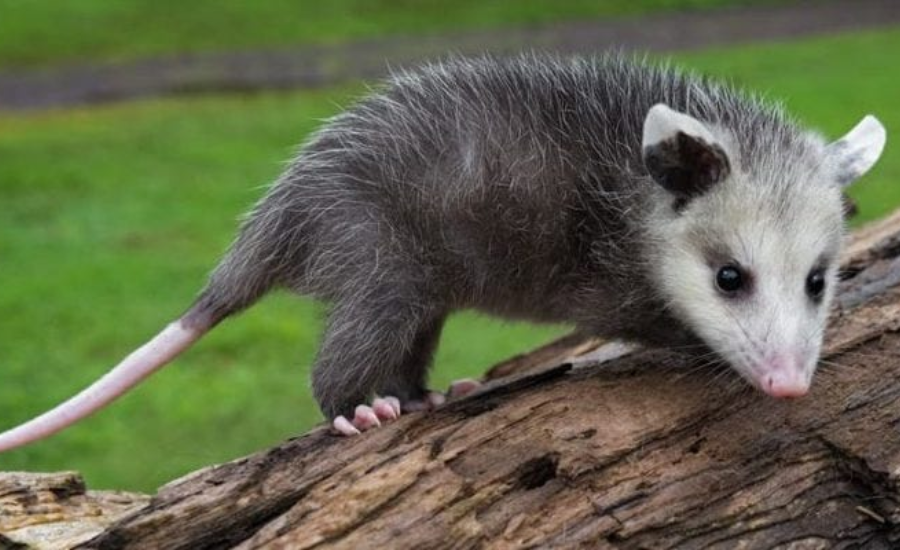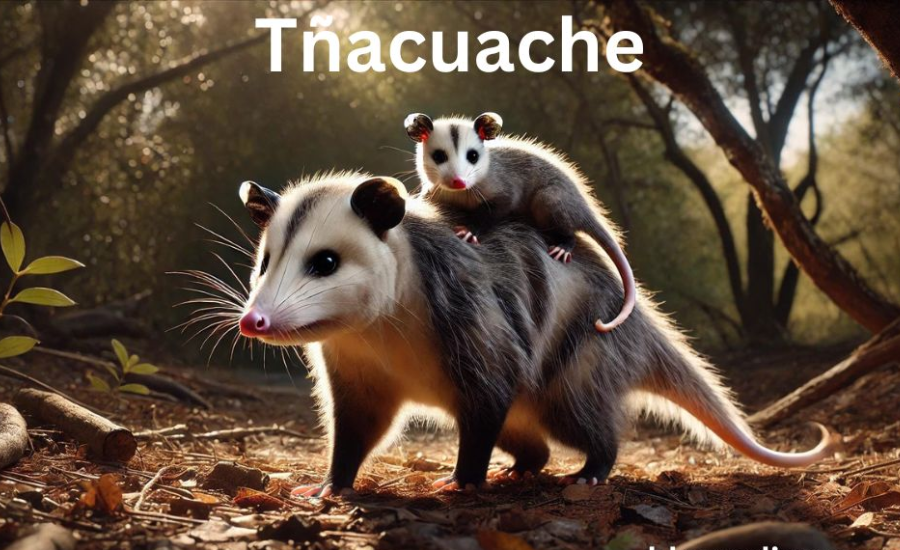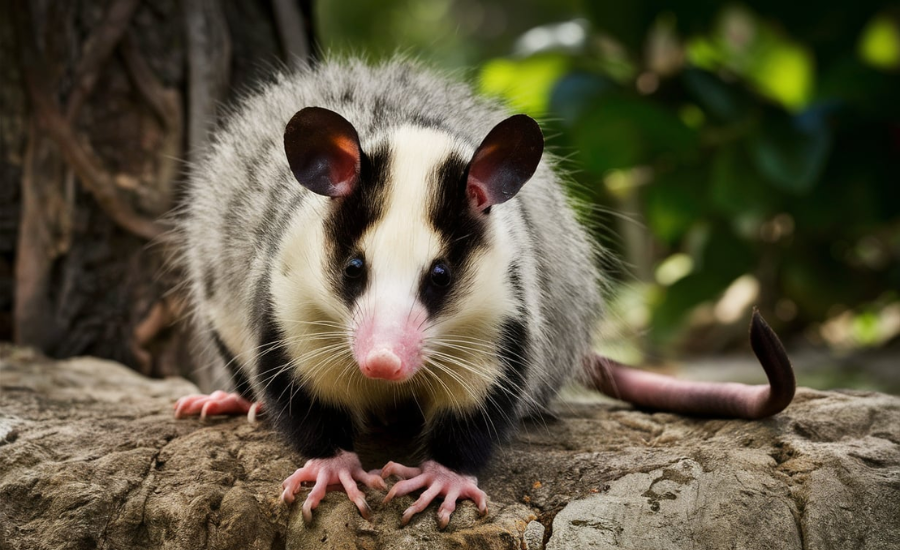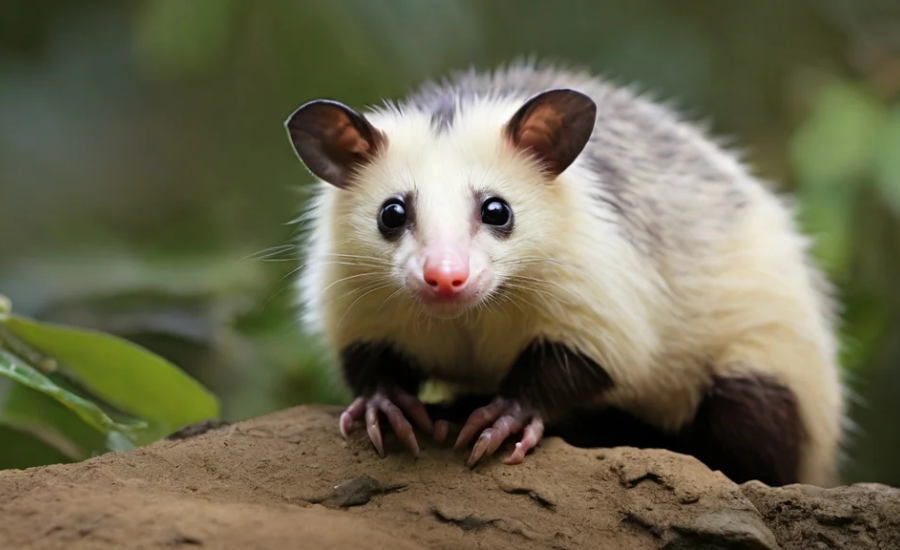The Tñacuache: Key Players In Maintaining Ecosystem Health And Biodiversity

The Tñacuache, commonly known as the opossum, is a fascinating creature that often remains overlooked despite its important ecological contributions. With its somewhat eerie appearance, this nocturnal mammal might not win any beauty contests, but it plays a crucial role in the ecosystems it inhabits.
One of the most intriguing aspects of the Tñacuache is its adaptability. Found across diverse environments, from woodlands to urban areas, the opossum is a true survivor. It has evolved a range of unique traits that enable it to thrive in various habitats. For instance, the Tñacuache possesses a prehensile tail, which acts like an extra hand, aiding in climbing and foraging. This adaptation is especially valuable for navigating the dense foliage of its natural habitat.
The Tñacuache’s diet is equally remarkable. As an omnivore, it has a diverse menu that includes fruits, insects, small animals, and even carrion. This dietary flexibility helps it maintain balance within its ecosystem by controlling insect populations and scavenging waste. Its role as a scavenger not only reduces the spread of disease but also helps in the decomposition process, contributing to nutrient cycling.
In addition to its ecological functions, the Tñacuache is a subject of fascination due to its unique defense mechanisms. When threatened, it can enter a state of tonic immobility, often referred to as “playing dead.” This involuntary response deters predators by mimicking the appearance of a dead animal, reducing the likelihood of an attack.
Despite these remarkable features, the Tñacuache is often misunderstood and unfairly maligned. Myths and misconceptions about its appearance and behavior can lead to unwarranted fears. For instance, its reputation as a “spooky” animal is largely due to its appearance and its habit of sometimes showing its teeth in a defensive posture. However, the opossum is generally a non-aggressive animal and poses little threat to humans.
What Is A Tñacuache?
A Name Rich in Cultural Heritage
The term “tñacuache” may seem unfamiliar to many, as it originates from indigenous languages. Specifically, “tñacuache” is a variation of “tlacuache,” a word derived from Nahuatl, the language historically spoken by the Aztecs. This name refers to a species of opossum, a marsupial native to the Americas. Beyond its linguistic roots, the tñacuache represents a deeper cultural significance, embodying a wealth of stories, traditions, and cultural meanings accumulated over centuries.
The Tñacuache’s Role in Nature
In its natural habitat, the tñacuache exhibits many traits characteristic of the opossum family. As a nocturnal animal, it is most active during the night, navigating through a variety of environments with impressive adaptability. Whether in lush forests, arid regions, or urban settings, the tñacuache demonstrates remarkable survival skills. It forages for a diverse diet and uses its keen senses to avoid predators, making the most of its surroundings.
What sets the tñacuache apart is not just its physical adaptability but also its integration into local folklore and daily life. Its presence has inspired various legends and cultural practices, highlighting the unique relationship between this marsupial and the human communities around it. The tñacuache’s role in both nature and culture underscores its significance as more than just another animal—it’s a symbol of resilience and adaptability.
Dietary Habits Of The Tñacuache

Tñacuaches are omnivorous, meaning they consume a varied diet that includes both plant matter and animal protein. Their diet is incredibly diverse, encompassing fruits, insects, small vertebrates, and even scavenged human food from garbage and compost bins. This wide-ranging diet allows them to adapt to different environments and find sustenance in a variety of settings.
One notable aspect of their feeding behavior is their role in pest control. Tñacuaches help manage populations of insects and small rodents, contributing to ecological balance by reducing the numbers of these potentially harmful pests. Their scavenging habits also aid in cleaning up waste, which can prevent the spread of disease and maintain a healthier environment.
Despite their occasional presence in urban areas, tñacuaches play a beneficial role in their ecosystems. By controlling pest populations and consuming waste, they help to preserve ecological harmony and contribute to a more balanced natural world.
Physical Characteristics Of The Tñacuache
Size, Shape, and Coloration
The Tñacuache, a common term for various species of opossums, exhibits a range of sizes and physical traits depending on the species. On average, these marsupials measure between 12 and 20 inches in body length, excluding their tail, and typically weigh between 2 and 15 pounds. Notably, male tñacuaches are generally larger than their female counterparts.
Their fur color and texture also vary among species. Many tñacuaches sport a grayish coat with distinctive white markings around their face, especially near their eyes. Some species may present darker hues, such as brown or black. The fur is usually dense and coarse, providing effective insulation in cooler climates.
Distinctive Features: Tail, Ears, and Eyes
One of the most notable features of the Tñacuache is its prehensile tail. This long, hairless tail is highly versatile, allowing the tñacuache to grasp and manipulate objects, aiding in climbing and maintaining balance. It is particularly useful for navigating the treetops of its arboreal habitat and carrying materials for nesting.
The Tñacuache’s large, rounded ears are another distinctive characteristic. These ears are typically hairless and exhibit a pinkish hue, designed to enhance their auditory sensitivity. This trait is crucial for a nocturnal animal, as it helps the tñacuache detect predators and prey in low-light conditions.
Their eyes are comparatively large and dark, adapted to function efficiently in dim environments. This adaptation supports their nocturnal lifestyle, enabling them to forage and explore their surroundings with greater precision during the night.
Species Variations
While these characteristics are common across many species within the Didelphidae family, there is significant diversity among different tñacuache species. For instance, the Virginia opossum (Didelphis virginiana) is one of the most well-known species, recognized for its striking white face and gray fur. In contrast, the water opossum (Chironectes minimus) is smaller and exhibits unique adaptations for a semi-aquatic lifestyle, such as webbed feet.
These variations underscore the tñacuache’s remarkable adaptability and evolutionary success, allowing different species to occupy a broad spectrum of ecological niches across the Americas.
The Environmental Importance Of Tñacuaches
Tñacuaches, or opossums, are crucial to maintaining ecological balance, though their contributions are often overlooked. Their role in pest control is significant; by consuming insects, small rodents, and other pests, they help regulate these populations, reducing the risk of disease spread and protecting crops from harmful infestations.
In addition to pest control, tñacuaches contribute to plant growth and habitat restoration. As they consume fruits, they inadvertently assist in seed dispersal. The seeds are transported through their digestive system and later excreted in different locations, fostering the growth of new plants. This natural process supports biodiversity and provides essential resources for other wildlife.
How To Support Tñacuaches In Your Area

If you reside in a region where tñacuaches are prevalent, there are several steps you can take to ensure their well-being. One key measure is to secure food sources and waste. Tñacuaches are opportunistic feeders and may be attracted to accessible food and garbage. To prevent potential conflicts, keep trash cans sealed tightly and avoid leaving pet food outdoors.
Creating safe environments for tñacuaches is also beneficial. Providing natural cover such as dense shrubs or trees can offer them refuge. It’s important to avoid the use of toxic chemicals and pesticides in your yard, as these substances can be harmful to tñacuaches and other beneficial wildlife.
Debunking Myths About Tñacuaches
Despite their valuable contributions to the ecosystem, tñacuaches are often the subject of myths and misconceptions. Some people mistakenly view them as unclean or hazardous. In reality, tñacuaches are meticulous groomers and maintain high standards of cleanliness. They are also less likely to carry diseases like rabies compared to many other wild animals.
Understanding the true nature of tñacuaches can help dispel these misconceptions. By appreciating their role and contributions, we can better support their presence in our environment and foster a healthier, more balanced ecosystem.
Health Benefits Of Tñacuache
Tñacuache is not only a visually appealing fruit but also a powerhouse of nutrients that can contribute significantly to your overall wellness. It is rich in antioxidants, which play a vital role in fighting oxidative stress, potentially reducing the risk of chronic diseases.
Packed with essential vitamins such as A and C, Tñacuache bolsters your immune system and supports skin health. Vitamin A is crucial for maintaining healthy vision, while vitamin C promotes collagen production, aiding in skin elasticity and wound healing.
This fruit also boasts a high fiber content, making it beneficial for digestive health. Consuming fiber-rich foods like Tñacuache can improve gut function, enhance satiety, and help regulate bowel movements.
The natural sugars found in Tñacuache provide a steady energy release, which can be a great way to curb sweet cravings without the drastic blood sugar spikes often associated with refined sugars.
Incorporating Tñacuache into your diet not only enriches your meals with vibrant colors and flavors but also offers a multitude of health benefits, making it an excellent addition for those seeking a nutritious dietary boost.
Steps To Cultivate Tñacuache In Your Garden
Growing Tñacuache at home can be a fulfilling project that yields delicious results. Here’s a step-by-step guide to help you successfully grow this fruit in your garden:
- Select an Ideal Location
- Sunlight: Choose a location in your garden that receives abundant sunlight throughout the day, as Tñacuache plants thrive in full sun.
- Soil Requirements: Ensure the soil is well-draining, as overly saturated soil can lead to root rot, hampering the plant’s growth.
- Prepare the Soil
- Soil Enrichment: Before planting, enrich the soil with organic compost to boost its fertility and supply essential nutrients that will support your plants.
- Spacing: Plant seeds or young plants about two feet apart to allow adequate space for growth and air circulation.
- Planting and Watering Guidelines
- Timing: Sow seeds or plant seedlings after the final frost of the season, preferably when the temperature is consistently above 70°F.
- Watering: It’s essential to maintain consistent moisture in the soil for optimal plant health, but be careful not to oversaturate.Water the plants regularly, adjusting the frequency based on weather conditions and soil moisture levels.
- Support and Maintenance
- Staking: As your Tñacuache plants grow and begin to bear fruit, provide support with stakes to prevent stems from bending or breaking under the weight.
- Fertilization: Apply a balanced fertilizer every four weeks during the growing season to encourage robust plant development and higher fruit yield.
- Ongoing Care and Harvest
- Pest Management: Monitor your plants regularly for pests such as aphids.
- Harvesting: Tñacuache plants may take several months to produce fruit, so patience is key. With consistent care, you’ll eventually be able to harvest and enjoy fresh Tñacuache from your garden.
By following these guidelines and dedicating the right level of care, you can cultivate healthy Tñacuache plants and enjoy the rewards of your gardening efforts with fresh, home-grown fruits.
The Ecological Role Of The Tñacuache

Key Seed Disperser in Ecosystems
Tñacuaches play a crucial yet often overlooked role as seed dispersers within their ecosystems. By consuming various fruits and berries, they inadvertently spread seeds through their droppings, facilitating the natural propagation of plants. This process is vital for the regeneration of plant life, especially in forested environments, where seed dispersal by animals like Tñacuaches supports the growth of diverse vegetation and maintains ecological balance.
Integral Part of Predator-Prey Dynamics
Occupying a unique position in the food web, Tñacuaches are omnivores that contribute both as predators and prey. They help control populations of insects and smaller animals, while serving as an essential food source for larger predators, including foxes, owls, and snakes. Their dual role enhances biodiversity and supports the stability of food chains. The Tñacuache’s behaviors, such as “playing dead” and being primarily nocturnal, are key survival strategies that reduce predation risks.
Enhancing Biodiversity and Ecosystem Health
Beyond seed dispersal, Tñacuaches contribute to ecosystem health through their scavenging habits, which help clean up carrion and reduce organic waste. This behavior not only limits the spread of disease but also plays a role in nutrient cycling within their habitats. Their presence is often a positive indicator of environmental quality, as they are sensitive to changes in habitat conditions and resource availability.
Cultural And Symbolic Significance Of The Tñacuache
Folklore and Mythological Figures
The Tñacuache holds a notable place in the folklore and mythology of various indigenous cultures across the Americas. Often portrayed as a clever and resourceful figure, the Tñacuache is celebrated in numerous myths, such as the Mesoamerican tale where it steals fire from the gods to give to humans, burning its tail in the process. This mythological origin is one reason why opossums are depicted with hairless tails in traditional stories, highlighting their adaptability and cunning.
Artistic Representation and Symbolism
The Tñacuache’s distinct appearance and traits, such as its prehensile tail and expressive features, have made it a popular subject in art, ranging from ancient pottery and textiles to contemporary illustrations and sculptures. In these artworks, the Tñacuache is often symbolized as a resilient and adaptable creature, embodying the ability to survive and thrive in challenging environments.
Modern Perception and Conservation of the Tñacuache
Today, public perception of Tñacuaches is mixed; while some see them as nuisances due to their scavenging behaviors, others acknowledge their ecological value. Conservation initiatives focus on protecting their natural habitats and promoting coexistence, especially in urban areas where human-wildlife interactions are common. Educational campaigns aim to reshape public attitudes, encouraging appreciation of the Tñacuache’s role in the environment and advocating for their protection.
Efforts to conserve Tñacuaches include habitat preservation and public education about their ecological contributions. By fostering a better understanding of their importance, these initiatives strive to ensure that Tñacuaches continue to thrive, supporting both biodiversity and the overall health of their ecosystems.
Conservation Strategies And Protection Initiatives For The Tñacuache

Preserving Natural Habitats
Efforts to conserve Tñacuaches primarily focus on preserving their natural habitats. Establishing protected areas and creating wildlife corridors are essential steps in maintaining stable populations. These safe zones provide the necessary environment for Tñacuaches to thrive, minimizing threats from urban development and reducing the likelihood of conflicts with humans. By ensuring access to food, shelter, and safe passage, these conservation measures support the long-term survival of the species.
Educational Outreach and Community Engagement
Public education plays a crucial role in Tñacuache conservation. Campaigns designed to inform communities about the ecological value of Tñacuaches aim to foster a positive attitude towards these animals. By highlighting their roles in seed dispersal and pest control, educational initiatives encourage people to coexist peacefully with Tñacuaches. Schools, community groups, and local organizations can participate in spreading awareness, emphasizing the importance of protecting this species as part of a healthy ecosystem.
Mitigating Human-Wildlife Conflicts
To address the common issue of roadkill and other human-wildlife conflicts, conservationists are implementing practical solutions such as wildlife crossings and underpasses. These structures help Tñacuaches safely navigate busy roadways, significantly reducing mortality rates caused by vehicle collisions. Additionally, promoting responsible waste management in urban areas can deter Tñacuaches from foraging near human dwellings, thus reducing potential conflicts and fostering safer environments for both wildlife and people.
Research and Monitoring
Ongoing research is vital to understanding the behavior, ecology, and needs of Tñacuaches. Conservation efforts benefit from studies that monitor population trends, habitat use, and the impacts of human activities on these animals. By gathering data, researchers can better inform conservation strategies and adapt them as necessary to ensure the protection of Tñacuaches. Collaboration between scientists, conservation organizations, and government agencies is key to developing effective measures that safeguard the future of Tñacuache populations.
Through a combination of habitat preservation, public education, conflict mitigation, and scientific research, conservationists are working towards a sustainable coexistence between humans and Tñacuaches. These efforts not only protect the species but also contribute to the broader goal of maintaining biodiversity and ecological balance in the regions where Tñacuaches live.
You may also read: 1-323-659-2214
FAQs About Tñacuache Conservation
1. Why is Tñacuache conservation important?
Conserving Tñacuaches is crucial because they play significant roles in ecosystems, such as seed dispersal and controlling insect populations. Their presence helps maintain biodiversity and ecological balance, making them valuable contributors to their habitats.
2. How can I help with Tñacuache conservation?
You can help by supporting local wildlife conservation efforts, educating others about the importance of Tñacuaches, and practicing responsible waste management to reduce human-wildlife conflicts. Volunteering with or donating to organizations dedicated to habitat preservation and wildlife protection can also make a positive impact.
3. What threats do Tñacuaches face?
Tñacuaches face several threats, including habitat loss due to urbanization, roadkill, and conflicts with humans. They are also vulnerable to environmental changes and pollution, which can affect their food sources and living conditions.
4. Are Tñacuaches protected by any laws or regulations?
In some regions, Tñacuaches are protected by wildlife conservation laws that aim to preserve their habitats and reduce threats from human activities. Specific protections vary by location, so it’s important to check local regulations regarding wildlife.
5. What are wildlife crossings, and how do they help Tñacuaches?
Wildlife crossings, such as overpasses and underpasses, are structures designed to help animals safely cross roads and highways. These crossings reduce the risk of vehicle collisions and are particularly effective in preventing roadkill, helping to protect Tñacuache populations in urban and suburban areas.
Conclusion
Conserving the Tñacuache is not just about protecting a single species; it’s about safeguarding entire ecosystems and promoting biodiversity. Tñacuaches play critical roles in their environments, from seed dispersal to pest control, and their presence is a positive indicator of ecological health. By preserving their habitats, educating the public, and implementing measures to reduce human-wildlife conflicts, we can ensure that Tñacuaches continue to thrive.
Through collaborative efforts involving communities, conservationists, and policymakers, we can create a balanced coexistence with Tñacuaches. These initiatives will not only help protect Tñacuache populations but also contribute to the overall health of our natural world. By recognizing the importance of Tñacuaches and taking steps to support their conservation, we contribute to a sustainable future for all species that share our planet.
Stay in touch with us for more updates and alerts! Discoverfuns





